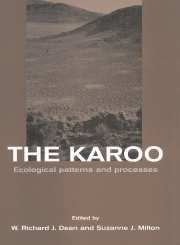Book contents
- Frontmatter
- Contents
- List of contributors
- Foreword
- Preface
- Acknowledgements
- Part one Biogeographic patterns and the driving variables
- Part two Form and function
- Part three Dynamics
- 11 Population level dynamics
- 12 Community patterns and dynamics
- 13 Modelling populations and community dynamics in karoo ecosystems
- 14 Spatially explicit computer simulation models – tools for understanding vegetation dynamics and supporting rangeland management
- Part four Human impacts
- Part five Comparisons
- References
- Index
13 - Modelling populations and community dynamics in karoo ecosystems
Published online by Cambridge University Press: 23 December 2009
- Frontmatter
- Contents
- List of contributors
- Foreword
- Preface
- Acknowledgements
- Part one Biogeographic patterns and the driving variables
- Part two Form and function
- Part three Dynamics
- 11 Population level dynamics
- 12 Community patterns and dynamics
- 13 Modelling populations and community dynamics in karoo ecosystems
- 14 Spatially explicit computer simulation models – tools for understanding vegetation dynamics and supporting rangeland management
- Part four Human impacts
- Part five Comparisons
- References
- Index
Summary
Introduction
Hall and Day (1977) define a model as any abstraction or simplification of a system and extension of scientific analysis by other means. A model should have some important functional attributes of the real system, although not all attributes are necessary, and is generally simpler than the real system. Modelling is used to aid the conceptualization and measurements of complex systems and also to predict the consequences of an action on the real system. According to Goodman (1990), models are ways to predict the behaviour of complex, poorly understood entities from the behaviour of parts that are already well understood. Models must, however, be checked frequently against the real world to ensure that the presentation is accurate. If the model and the real world disagree, then one or the other, or both, are imperfectly known and, by finding points of difference, the understanding of the real world or the model system will be increased. A principal use of models is, therefore, to test the validity of field measurements and assumptions made from the data. The ultimate function of modelling is to know more about the structure and behaviour of natural systems, both now and in the future. Models are one tool of many that can aid us in this process, especially in interdisciplinary research. Models can incorporate known spatial heterogeneity of biological, physical and environmental components, such as the vegetation, soils and climatic parameters. Major drawbacks are the numerical complexity and large number of input parameters which often require long-term research (Keating et al., 1995). Different aspects influencing the dynamic process can be explained in several submodels.
- Type
- Chapter
- Information
- The KarooEcological Patterns and Processes, pp. 224 - 230Publisher: Cambridge University PressPrint publication year: 1999
- 1
- Cited by

